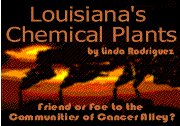|
|
Emphasis
on Health & Safety
It cannot
be denied that there is a certain amount of risk to the health and safety
of the industry's employees, communities, and environment, however, the
industry stresses that their advocacy in minimizing these hazards are continuous
and stringent. Responsible Care ® is a program that was developed voluntarily
by the industry in 1988 to address and change the way business was being
done in the communities and to promote health and safety by the industry.
Responsible Care ® has established stringent health and safety regulations
and codes that go beyond the federally mandated regulations and codes of
OSHA.
Many of the
Mississippi River plants are members of industry organizations that comply
with these strict regulations. Among these organizations are the American
Chemistry Council, the American
Petroleum Institution, the Chemical
and Allied Industries' Association, and the National Petrochemical and
Refining Association, to name a few.
The
Louisiana Chemical Association (LCA) statistics show that Louisiana,
when compared to the United State, has consistently maintained a lower rate
of health and safety related incidences.
In 1998, Louisiana's "chemical and allied products" division had
an incident rate of 3 out of every 100 employees, compared to 4.2 for the
national rate. 1997 rates show Louisiana at 1.9 while the national rate
was 4.8 out of 100 employees.
LCA also reports
that its members have reduced Toxic
Release Inventory (TRI) emissions by 80% since its initial reporting
in 1987.
|
More
Health & Safety Measures Needed
- In a report
released by the National Environmental Trust (NET), Physicians for Social
Respnsibility and the Learning Disabilities Association, Louisian and Texas
were found to emit the most developmental and neurological toxins to air
and water (Global Wire Service, Environment News Service, Sept. 7, 2000).
The National
Academy of Science estimates that three percent of the developmental
and neurological defects in children (1 out of every 200 U.S. children)
are caused by known toxins. However, the majority of the more than 80,000
chemicals used commercially have not been tested for developmental and neurological
effects.
- Greenpeace
and the Working Group on Community Right to Know collected data from the
EPA and determined Cancer Alley to be "one of the most serious threats
of a catastrophic chemical accident in the US" (Chemical News &
Intelligence, Glenn Hess, March 23, 2001).
According
to the activists, the "worst-case scenarios," prepared by 50
of Louisiana's chemical producers, show that more than one million people
could be affected by one chemical accident in the area.
-
The 1998
Toxic Release Inventory
(TRI) report by the EPA showed PCS Nitrogen Fertilizer, a plant in Ascension,
LA , to have the third highest annual toxic release in the US with over
10,000 tonne released. In the state of Louisiana, nearly 130,000 pounds
of toxins were released (Chemical News & Intelligence, Glenn Hess,
May 11, 2001).
|

